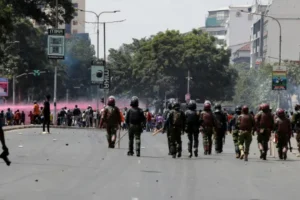On Monday, the head of European diplomacy, Josep Borrell, said that the training of Ukrainian pilots to fly American F-16 multirole fighters had already begun. The Ministry of Defense of Ukraine said that these planes, whose full name is translated into Russian as “Fighting Falcon”, will rise into the Ukrainian sky in the fall. Volodymyr Zelensky called the US consent to the transfer of F-16s to Ukraine a “historic moment”, and US President Joe Biden called it a “colossal risk”, but not for Ukraine, as they say in Moscow, but for Russia itself.
Some military experts and analysts, however, doubt that Ukrainian pilots will be able to quickly learn how to effectively use the F-16 against Russian air defense systems and modern Russian fighters. Radio Liberty explores how Western fighter supplies could affect the course of hostilities.

What modifications of the F-16 may end up in Ukraine?
The General Dynamics F-16 Fighting Falcon is an American single-engine multirole fighter. If the old Soviet aircraft can perform only one function – a bomber or a fighter, then the F-16 is versatile: it can perform various tasks and carry both air-to-air and air-to-ground weapons. The F-16 is in service with many countries: in 2023, there are about 2,200 active fighters of this type worldwide .
In recent years, the F-16 has been gradually replaced by more modern F-35 fighters. Thomas Tainer, an independent military expert and former Italian army soldier, notes that Norway and the Netherlands now have the most “released” aircraft as a result of this replacement. Two more countries that have chosen the F-35 as a replacement for their F-16s are Belgium and Denmark, but the first has not yet received a single new fighter, and the second has replaced only a few old machines with them. Norway agreed at the end of 2022 to sell 32 F-16s to Romania. As a result, Tyner believes, Kyiv can receive from 40 to 60 fighters from the allies.
The F-16 was developed back in the late 70s of the last century and has been upgraded many times since then. Deep modernization, including new engines and changes in the design of the airframe, such as new lights (the transparent part of the cockpit), divides all F-16s produced into several main series. The first A/B series (single/double variant) was replaced in 1984 by the C/D series, which in turn was replaced by the E/F series in the late 90s.
At the same time, F-16s are divided into “blocks” – their numbering changed as new technologies were introduced into the aircraft that did not require structural changes. So, the modification of C / D began with block 25, and E / F – with block 60. As new blocks were released, the radar, electronic systems and avionics were improved in the aircraft. The most modern version at the moment is Block 70/72.

The United States – the owners of the largest fleet of F-16s – has not yet announced the transfer of part of its fighters to Ukraine. Most likely, Ukraine will receive the F-16AM Block 20 MLU , which are in service with Denmark, Belgium, Norway and the Netherlands. This version of the F-16 has undergone a deep internal modernization and in almost all characteristics, except for the appearance and radar, corresponds to a more modern modification – the F-16C / D Block 50/52.
European countries that have “released” F-16s have first-generation aircraft – single-seat “A” and two-seat “B” (the latter are mainly used for pilot training and are unlikely to be transferred to Ukraine, since training will take place on the territory of donor states ). At the same time, notes Thomas Tyner, these F-16s have been upgraded with technologies used in the C/D series (blocks 50/52). At the same time, the airframe of the aircraft remained old and in some cases may have a large amount of flying time, which reduces the time until the next deep technical inspection.
There is one more minus: despite the modernization of avionics and electronic data transmission system, the radars of the Belgian and Danish F-16s remained old. “The radar is one of the most expensive elements of the F-16, structurally the new generation radars are no different from the old ones and are interchangeable. European countries decided to save money by improving the radar data transmission system and computer processing. In the USA, even the” new “radar is now being removed from aircraft and are being replaced with even more modern ones, so I hope they will pass on the radars of the previous modification to those European countries that are going to send their F-16s to Ukraine.”
The US, says Thomas Tyner, also has a significant number of F-16s from blocks 20, 25 and 30. Units that have these fighters are now receiving more modern aircraft (blocks 50 and 52), which, in turn, are being released as they enter the F-35 troops. “For example, the United States has a squadron of F-16s in Japan. Now they are being replaced by F-35s, and the freed F-16s are being transferred to the California Air National Guard, which now flies F-16s from Block 20. The United States does not have many F- 16 of blocks 50 and 52, but if at least some of them are transferred to Ukraine, it would be very good,” the expert believes.
On enemy radars, the F-16 is slightly less noticeable than the MiG-29 aircraft in service with the Ukrainian army, but this is not an “invisible aircraft”. It is capable of reaching speeds of up to 2,500 kilometers per hour and climbing to a height of up to 16-17 kilometers, can detect targets at a distance of up to 150 kilometers and track ten objects simultaneously.
What missiles will Ukraine use with the F-16?
F-16s are adapted to carry a huge amount of different types of ammunition. Thomas Tyner believes that Ukraine will first need air-to-air missiles – not to shoot down Russian warplanes, but to destroy cruise missiles and Iranian kamikaze drones.
“To perform such tasks, F-16s will be able to remain in Ukrainian airspace without exposing themselves to the risk of being shot down by air defense systems or Russian fighters. European countries have tens of thousands of such missiles, and if they are transferred to Ukraine, this will save Europe itself from the need to supply Kiev with additional costly air defense systems such as the Patriot, such as the American AIM-9 Sidewinder guided missiles and AIM-120 AMRAAM medium-range missilesdesigned to destroy air targets beyond the line of sight. The former use the thermal silhouette of the target for guidance, the latter use the radar. In order to be able to shoot down Russian fighters, Ukraine will need the most modern modification of the AIM-120 AMRAAM. The problem is that the F-16s that Denmark, the Netherlands and Norway have don’t have enough advanced radar to use these missiles – their radars simply don’t see the target at such a distance that these missiles can travel.”
Thomas Tyner emphasizes that another important task for the Ukrainian army is to neutralize enemy air defenses, and some modifications of the F-16 are specially “sharpened” for it, for example, the F-16CM and F-16DM. The main tool for this task is the AGM-88 HARM missiles, which were already delivered to Ukraine in 2022 and were adapted for launches from Soviet fighters at the disposal of the Armed Forces of Ukraine. This combination limits Ukraine’s ability to destroy Russian air defense systems, since literally ideal conditions are needed for effective work in this case.

“Here we are faced with another problem: the F-16CM and F-16DM were released quite a bit, only about 300 aircraft. HARM anti-radar missiles can also be used with “regular” F-16s, but they are less protected from enemy interference and electronic warfare systems,” Radio Liberty’s interlocutor says.
As for modern Russian fighters, which, due to long-range missiles and modern radars, can shoot down Soviet aircraft in service with the Armed Forces of Ukraine, as well as air defense systems, then, according to Thomas Tyner, to counter these threats, the Ukrainian army needs AIM-120 missiles of modification C -5 and C-7 with increased noise immunity, upgraded radar homing head and increased firing range. The restriction will remain the same – old-style radars, which, most likely, will be on the F-16 fighters transferred to Ukraine.
Missile AIM-120:
Will these F-16s be used against enemy troops and military installations located on the ground? Tainer sees this as a significant risk and does not consider such use of American fighters a priority for the Armed Forces of Ukraine in the conditions of airspace covered by Russian air defense systems. According to him, Israeli loitering ammunition (actually the same “kamikaze drones”) Harpy, designed to destroy radar stations, could help here, but so far there is no talk of transferring them to Ukraine. At the same time, Tyner says, Ukraine will be able to launch missiles from the F-16 that are close in performance to the Storm Shadow cruise missiles it has already received, and in the future, long-range anti-ship missiles LRASM. The latter are capable of covering a distance of up to 1000 kilometers and can become a serious challenge for the Russian Black Sea Fleet,
Risks and challenges for Ukraine
Despite the extensive range of weapons and good performance, some experts question the effectiveness of American fighters in the conflict in Ukraine. US Senator and Arms Committee member Jack Reed insists that supplying fighter jets to Ukraine is not a priority, as Ukrainian pilots will not be able to use the full potential of American aircraft due to the activity of Russian aviation and air defense systems. “Ukraine already has planes, but Ukrainians don’t use them very often – the situation in the air doesn’t allow it. It’s extremely difficult to take off in these conditions. Now they take off and fly at low altitude, and rise sharply to drop ammunition. The Ukrainians have already lost such image of several pilots,” says Reid.
John Hohn and William Courtney , analysts at the RAND research organization, also believe that it will be quite difficult to get the F-16 into Ukrainian skies. Experts point out that the F-16 needs a long and smooth runway, and on the rougher and uneven Ukrainian runways, the F-16 may run into problems. From here, according to analysts, the following problem follows: Ukraine needs to improve and expand several runways, which the Russian armed forces will definitely notice. “If there are only a few suitable airfields in Ukraine, and Russia knows their location, it can take advantage of this and attack these objects,” RAND analysts write.

Another problem is the training of pilots and staff. Griffith University staff member and former Australian Air Force member Peter Layton notesthat it is possible to train Ukrainian pilots to operate the F-16 in three months – after that the pilots will be able to take off, stay in the air and land. The use of these aircraft in combat conditions requires, according to Layton, more comprehensive and lengthy training. He believes that Ukrainian pilots can quickly learn how to shoot down Russian aircraft and missiles, but it takes a long time to learn how to effectively use a wide range of Western weapons and strike ground targets at low altitudes and in low visibility conditions. An unnamed F-16 pilot told CNN that training in all the intricacies of combat in this fighter could take years.
While it is theoretically possible to train pilots in three months, it will take significantly longer to train technicians, according to a recent report by the US Congressional Research Service. F-16 personnel are trained in English and take up to 133 days, but it takes at least a year to become truly qualified, the report says. The F-16 is quite whimsical in terms of maintenance: for one flight hour there are 16 hours of maintenance with all the necessary equipment and well-organized logistics. The report considers the possibility of attracting specialists from third countries to service the transferred fighters, but the speakers note the high cost and political risks of such a decision.
Thomas Tyner, in an interview with Radio Liberty, partly agrees with these warnings, but does not consider the challenges facing Ukraine to be unsolvable. The problem of lack of service personnel, according to the expert, can be solved by attracting volunteers from other Western countries, many of whom have extensive experience in servicing American fighters and have already expressed their willingness to come to Ukraine. The same goes for pilots. The political risks, Tyner says, could be reduced if Kyiv developed a program to rapidly grant Ukrainian citizenship to foreign pilots.
The Congressional Research Service writes about another issue: the cost of armament that makes the F-16 truly effective. The price of one AIM-120 missile, for example, is more than a million dollars, and the time from the conclusion of the contract to the delivery of the finished product is two years. The report notes that the US can provide AIM-120 from its own stocks, but this imposes certain risks in the event of a direct US conflict with another state.
“As there will be no more in Mariupol”
While Ukraine managed to keep Russia out of air superiority during this war, with Soviet fighters remaining in its possession, it is increasingly suffering from a shortage of spare parts for them. The F-16s do not outperform the most modern Russian fighters, such as the Su-35, but they can at least solve the problem of “cannibalizing” Soviet aircraft when they have to be dismantled for parts in order to extend the life of the remaining machines in flying condition.
in the future, they could quickly be trained to fly more modern versions of the F-16, which outperform any aircraft Russia has. The only question is whether Kyiv will receive such equipment in the foreseeable future and what kind of F-16s it will receive now,” concludes Thomas Tyner.
Source : Радио Свобода











